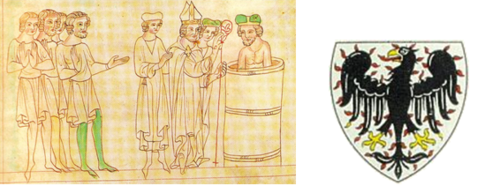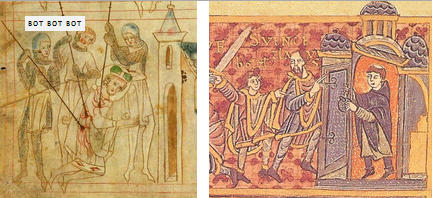We don’t really know the origins of Přemyslid dynasty (Czech: Přemyslovci) if we aren’t counting the legend about Přemys Oráč or speculations about them being part of Moravian lineage.
The first documented duke of Bohemia was Bořivoj (872?–883?), probably put on throne by duke Svatopluk of Moravia in 867, still during the existence of Great Moravia. After Bořivoj’s death Bohemia emancipated from Great Moravia and turned to western religion.

1) Baptism of the duke Bořivoj by St. Methodius 2) Before the silver lion Přemyslids had on their coat of arms black flaming eagle.
For the next 300 years the relationship with Eastern Franks and later Holy Roman Empire was rather difficult, accompanied by constant struggle with German neighbours and their emperors appropriating the right to intervene in Czech matters. Czechs were many times buying peace by paying tribute.
Boleslav I the Cruel (935 – 967/72), alleged murderer of his brother Saint Wenceslas, unsuccessfully tried to abandon this habit but was defeated by Emperor Otto I. Boleslav was actually pretty successful ruler and in 995 he and Otto I defeated Hungarian tribes, ending their European expansion.

The fratricidal murder of Saint Wenceslas (Czech: Svatý Václav). According to the legend Wenceslas tried to hide in the chapel but the priest refused to open the door for him. What an asshole...
Boleslav II the Pious (967/72 – 999) finished unification of tribes living in Bohemia, established the first bishopric in Prague and murdered another Czech lineage for unknown reason. After his death the Czech state got into huge crisis followed by many years of struggle for the throne.
Boleslav III the Red-haired (999-1002) was described as “the worst man that ever sat on the throne” and for his cruelty expelled by Vršovci family.
Polish duke Bolesław I Chrobry helped on Czech throne his notoriously alcoholic brother half-Přemyslid Vladivoj who out of fear that somebody would attack his position lets in 1002 Emperor Henry II grant him Czech lands as fief to make him his ally. He was the first Czech ruler to do so and since then were Czech lands considered part of the Holy Roman Empire, giving emperors right to intervene. After Vladiovj drinks himself to death Boleslav III comes back to revengefully murder Vršovci family but is forced to leave by Bolesław I Chrobry once again.
Bolesław I Chrobry (1003 – 1004) tried to create Czech-Polish Empire against the Reich but his efforts failed when Henry II, realizing the possible danger of such a big neighbour, allied with Přemyslid Jaromír and with Czech help Poles were banished from Bohemia.
Even though Moravians stayed loyal to Bolesław I Chrobry, Moravia was later conquered back by Přemyslid Oldřich (1012-1013), becoming a permanent part of the Czech state. Oldřich was later forcibly taken down for a year by the Emperor for refusing to aid in attack on Poland.

Vratislav II, Vladislav II, Břetislav…from preserved skeletal remnants we have pretty good idea how Přemyslids looked. Even though most of them had muscular, athletic figure they were no huge warriors and possessed nearly feminine looks (especially in the face). Their hair was either brown or auburn.
Břetislav (1034–1055) was Oldřich’s bastard son and unlike his father he had no scruples about invading Poland. This provoked conflict with the Emperor Henry II who demanded the Polish booty and for Czech soldiers to retreat from Silesia. Conflict between Henry II and Břetislav despite initial Czech victories ended in Břetislav’s defeat. Břetislav had to pretty humiliatingly beg Henry for forgiveness in Resenburg, only to later become one of Henry’s most valuable allies.
Vratislav II (1061–1092) was the first Czech ruler that got the title of Czech king for being a good friend an ally to Henry III against Piasts, Swabia and Meisse, however, that tile wasn’t hereditary.
Vladislav II (1140–1172) was at first elected for being “young and flippant” but to great disappointment of Czech lords he ruled with strong hand and later even suppressed their revolt. For aiding Emperor Frederick I Barbarossa in his raid against Italian cities Vladislav II finally received the title of king with the promise of hereditary possession. During Vladislav’s reign the country was in a huge boom but after his death the kingdom for a quarter of a century experienced a huge decline of power, proving the excessive dependence on the Reich as ill-advised.
Next: Last Přemyslids and Luxembourgs on Czech throne
































































